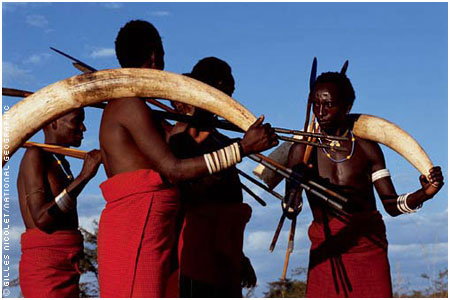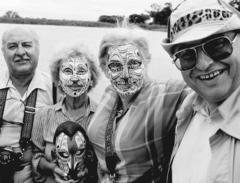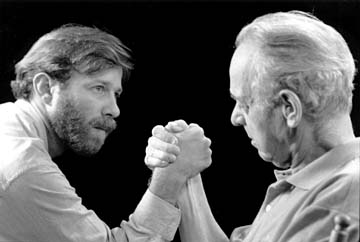 Obviously, Greenwald puts a bias behind his work. And, of course, one expects this bias going in to the screening of Outfoxed: Rupert Murdoch's War on Journalism. The film reveals the danger of opinion-driven media, which may seem to be a contradiction considering Greenwald’s list of accomplishments and the obvious one-sidedness of Outfoxed. The film exposes Rupert Murdoch’s control over an entire news corporation, the aptly named News Corporation. NewsCorp owns Fox News Channel, which becomes the target of Outfoxed due to its extreme right-wing bias that seems to discredit the channel’s ‘Fair and Balanced’ motto. Fox portrays itself as the provider of objective news that informs its audience in a ‘fair and balanced’ way. This is the primary difference between Greenwald’s documentary style and Fox News’ reporting style: they both convey extreme political leanings and obvious intentions in their messages, but only one makes this evident to its audience. This is the danger of Fox News, NewsCorp, and Rupert Murdoch – one (right-winged) man manipulates an entire network in order to express his personal political viewpoint. The manipulation of news, even beyond Fox or NewsCorp, is worth fighting against, because, as Outfoxed reveals, “media is the nervous system of the democracy” (Jeff Cohen, FAIR).
Obviously, Greenwald puts a bias behind his work. And, of course, one expects this bias going in to the screening of Outfoxed: Rupert Murdoch's War on Journalism. The film reveals the danger of opinion-driven media, which may seem to be a contradiction considering Greenwald’s list of accomplishments and the obvious one-sidedness of Outfoxed. The film exposes Rupert Murdoch’s control over an entire news corporation, the aptly named News Corporation. NewsCorp owns Fox News Channel, which becomes the target of Outfoxed due to its extreme right-wing bias that seems to discredit the channel’s ‘Fair and Balanced’ motto. Fox portrays itself as the provider of objective news that informs its audience in a ‘fair and balanced’ way. This is the primary difference between Greenwald’s documentary style and Fox News’ reporting style: they both convey extreme political leanings and obvious intentions in their messages, but only one makes this evident to its audience. This is the danger of Fox News, NewsCorp, and Rupert Murdoch – one (right-winged) man manipulates an entire network in order to express his personal political viewpoint. The manipulation of news, even beyond Fox or NewsCorp, is worth fighting against, because, as Outfoxed reveals, “media is the nervous system of the democracy” (Jeff Cohen, FAIR).
There are numerous techniques revealed in the film that Fox News uses to promote their Republican stance and to, essentially, eliminate any objective, informed news broadcast from their network. Three such techniques are: 1. the emphasizing of opinion-based programs or news segments; 2. the lack of factual support with the use of the phrase “Some people say”; 3. the ‘confusing’ of issues in order to hinder the strength of the left-wing.
- Outfoxed demonstrates how a great majority of Fox News isn’t even news at all because it is so drenched in commentary by the right-wing correspondents. Segments like Bill O’Reilly’s “Talking Points” are the perfect opportunity for Fox to transmit their biases to viewers as a form of opinion. Fox supports the use of opinion-based news because opinion can not be proven wrong. However, the news is supposed to provide facts, it’s supposed to relay information objectively to its viewers to keep them informed about the world around them. Fox News has essentially eliminated journalism. As Bob McChesney says, “it’s stripped out any notion of journalism as we’ve traditionally understood it … There is no journalism at the Fox News Channel” (Outfoxed). Especially considering Fox’s ‘Fair and Balanced’ slogan, the overuse of opinion-based news is an abuse of the media outlet.
 A more specific technique that supports the lack of factual information at the Fox News Channel is the use of the three simple words “some people say”. Peter Hart, a media analyst from FAIR, explains in the film that this phrase is a clever way of inserting political opinion when you know it probably shouldn’t be there. This phrase allowed “Bill O’Reilly [to find] similarities between “radical” Nevada voters and Nazis” (Eric Alterman, The Real ‘Fake News’). By connecting this phrase to a statement, it relieves the correspondent of the need for providing any grounds or reference to its source. “Some people say” emphasizes the lack of journalism at the Fox News Channel. Another method that wasn’t mentioned in Outfoxed but that is very similar to the “some people say” technique is the question mark technique. The video clip shows Jon Stewart’s explanation of the question mark on The Daily Show. He explains how Fox News’ uses the question mark to basically allow anyone to make any claim they want, as long as it’s in the form of a question and not a statement. I don't know how to attach the clip, so follow the link: http://www.youtube.com/watch?v=fpChNJbILZM
A more specific technique that supports the lack of factual information at the Fox News Channel is the use of the three simple words “some people say”. Peter Hart, a media analyst from FAIR, explains in the film that this phrase is a clever way of inserting political opinion when you know it probably shouldn’t be there. This phrase allowed “Bill O’Reilly [to find] similarities between “radical” Nevada voters and Nazis” (Eric Alterman, The Real ‘Fake News’). By connecting this phrase to a statement, it relieves the correspondent of the need for providing any grounds or reference to its source. “Some people say” emphasizes the lack of journalism at the Fox News Channel. Another method that wasn’t mentioned in Outfoxed but that is very similar to the “some people say” technique is the question mark technique. The video clip shows Jon Stewart’s explanation of the question mark on The Daily Show. He explains how Fox News’ uses the question mark to basically allow anyone to make any claim they want, as long as it’s in the form of a question and not a statement. I don't know how to attach the clip, so follow the link: http://www.youtube.com/watch?v=fpChNJbILZM- One method that Fox uses to damage the image of left-wing supporters or to undermine the merit of Democratic issues is to misconstrue the facts of an issue until they are too muddled together to figure out who the ‘winner’ is. This a method used often in situations where the left-wing is quite obviously the stronger candidate of the two. An example given in the film is when Richard Clarke, the National Coordinator on the United States National Security Council, apologizes for failing the country after the attack of 9/11. Fox News suggested on many different occasions that Clarke was a supporter of the Democratic Party and used this to complicate the situation, especially since it was around the time of the upcoming presidential election. James Wolcott explain that this technique is effective because it tricks the viewer into believing that there is no clear ‘winner’, which means that the Republicans, or the Fox News Channels’ correspondents, are not the ‘losers’. The news anchors and journalists working for Fox are almost all right-wing supporters, as are the majority of the guests. The left-wing correspondents or guests are either silenced by the pushy anchors or are “liberals who specialize in bashing liberals and liberalism” (Eric Alterman, The Real ‘Fake News’). Alterman goes on to argue that “liberals ought to refuse to participate at all because it is impossible to do so without playing by Fox’s fixed rules”.
The film outlines the many, many techniques implemented by the Fox News Channel that allows blatant political opinion to be broadcast as news. These three examples are techniques that stood out to me because they demonstrate how simple it can be to manipulate the truth in the eyes of the public. The use of a simple phrase or the slander of a political party is not the most sophisticated method for ‘tricking’ the public into believing your ideals or beliefs. It’s scary how easily the truth can be altered, which makes me think back to The Couple in the Cage. The deception of the two actors is obviously very different than the operation of Fox News, but they both reveal the ease of deception when there is status or preconceived notions involved. In the context of a museum or in the context of a news broadcast, the public will generally believe what they are told. This is a great danger that we must be aware of when looking at documentary media of any kind and the production of reality that ensues.







